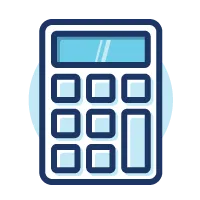What We'll Cover
- A strategy for what goals you should work towards first when you start saving money
- How to pay off debt faster so you can focus on saving more money
- Guidance on saving for retirement and building general wealth
- Where short-term savings goals fit into your overall savings plan
Did you know Americans rank at the bottom of the list when it comes to saving money?
In general, American families in the United States save only about 3% of their household income. Compare that to Germany at 10%, Switzerland at 19%, and Japan at 27%, and you can see Americans are not doing well when it comes to saving a portion of their income.
The solution is to start with how we prioritize our savings. Whether you’re just starting out or you’ve tried saving money without success, here are the savings goals to work on in order of priority.
1. Starter Emergency Fund
When it comes to saving money, the first thing you must save for is a starter emergency fund. This is simply a savings account where you quickly save between $500 and $2,000 depending on your current lifestyle and expenses.
Why Only $500 - $2,000?
You’ve probably heard a fully funded emergency fund is between three and six months' worth of expenses, right? That amount is great for a fully funded emergency fund. But for now we’re focusing on a starter emergency fund to get you prepared for life’s financial hiccups.
When thinking about your current lifestyle and expenses, you’ll realize that most of your financial hiccups can be solved with between $500 and $2,000. This could be a deductible made on an insurance claim, a new hot water heater, an auto repair, etc.
Pro Tip: Since you can handle most of life’s financial hiccups with a smaller starter emergency fund, start here and then add to it later when you build your fully funded emergency fund.
2. All Non-Mortgage Debt
I know, paying off debt is not the same as saving money.
But can you imagine how much more money you could save if you didn’t have any debt? Think about how much of your income goes to credit card debt, personal loans, student loans, auto loans, or any other type of non-mortgage debt.
Once you have your starter emergency fund finished, the next goal is to get rid of your non-mortgage debt as quickly as possible. Of course this is easier said than done, but the key is to become laser focused on paying off your debt using a debt payoff strategy.
The Debt Snowball Strategy
The debt snowball strategy works well because it focuses on your behavior with money.
When you’re setting up your debt snowball, list all your debts from lowest balance to highest balance, and ignore the interest rates. Yes, you read that correctly — ignore the interest rates.
The debt snowball ignores the interest rates and focuses on the balance because debt isn’t a result of poor math but rather an issue with our behavior with money.
For example, no one ever signs up for a credit card at 18.00% APR so they can carry a balance each month — but they still do. It’s not the math that we need to fix; it’s our behavior with money.
With the debt snowball method, you make minimum payments on each debt on your list and then you attack the smallest debt first. Do this and you’ll pay the first debt off quickly and get a win!
That win starts to change your behavior with money. Then, by the time you get to the largest balance on your list, you’ll have paid off all prior debts and your improved behavior with money will help you see your debt payoff through.
3. Three-to-Six-Months Emergency Fund
Now you’ll revisit the starter emergency fund and build it to between three and six months' worth of emergency expenses.
This shouldn’t be as difficult as it may have appeared earlier because at this point you’re debt free (minus the mortgage) and you already have a starter emergency fund in place.
Now it’s time to add up all of your monthly essential expenses — the expenses that still need to get paid even during a financial crisis.
This includes:

Mortgage Payment or Rent

Utilities

Basic groceries

Fuel for your car
![]()
Auto loan payment

Insurance premiums
Once you determine how much you need each month in emergency expenses, then choose between a three- and six-month amount. If you’re in a career that has less stability, then you may want to lean closer to a six-month emergency fund. On the other hand, if you work a job that is much more stable, then you might choose a three-month emergency fund.
4. Saving for Retirement
Financial experts recommend saving 15% of your gross income into tax-favored retirement accounts. That’s a hard pill to swallow when any extra income you have goes out in the form of debt payments or the next financial emergency.
The reason why retirement savings is at number 4 on this list is because with a fully funded emergency fund and no debt, investing 15% of your gross income goes from a wish to a reality.
If your employer offers a 401k plan, start there. If you’re self-employed or your employer doesn’t have a retirement benefits plan, then you can open a traditional IRA or ROTH IRA.
5. Saving for Children’s College Expenses
If you have children and you plan on them attending college, you have the option of saving money into tax-advantaged savings accounts such as a 529 plan or a Coverdell Education Savings Account (ESA) to help pay for college.
Both 529s and ESAs are great options and each of them is structured a little differently.
For example, an ESA allows you to save only $2,000 per year where a 529 plan virtually has no limit for savings. Both savings vehicles allow the money inside to grow tax-free and you won’t pay any taxes on the withdrawals when used for qualified educational expenses.
The main difference between the 529 plan and ESA is that an ESA allows you to use the savings for both elementary and secondary education expenses in addition to college.
On the other hand, a 529 can only be used for post-secondary education.
6. Short-Term Savings Goals
After you fund your future retirement and college savings, the next goal to reach for is short-term savings.
Short-term savings goals are for things you will need money for in the six-month to five-year range. This could be for an upcoming vacation, a new car, a wedding, or a down payment for a new mortgage.
When saving for these short-term goals, you’re looking for a lower-risk savings vehicle such as a savings account, money market account, or a share certificate.
7. Building for Generational Wealth
Building generational wealth means you will continue building an even larger nest egg that will not only support you well into your later years, but will actually outlive you and then get passed down through your family’s generations.
Where do you start with building generational wealth? Seek counsel from others who are or already have built high levels of wealth. Meet with a financial advisor, a real estate expert, or identify other areas that interest you when it comes to wealth building.
Frequently Asked Questions
Now that you have the 7 savings goals in order, here are answers to some of the most common questions when it comes to prioritizing your savings goals.
What is the Best Account for My Emergency Fund?
A savings account or a money market account.
The key to an emergency fund is having immediate access to the funds without incurring a penalty. Of course there are better options for parking money that will give you a much higher rate of return, but the point of an emergency fund isn’t to generate a higher return. Your emergency fund’s only job is to protect you from financial emergencies.
Should I Stop My Retirement Current Contributions?
It all depends on how long it will take you to get through the first 3 savings goals (starter emergency fund, getting rid of non-mortgage debt, and fully funded emergency fund).
For example, if you have a large student loan payment that may take 10 years to pay off, then it wouldn’t be wise to wait 10 years to start saving for retirement. On the other hand, if you think you can build an emergency fund and pay off all non-mortgage debt within 1 to 2 years, then pushing pause may be a better option.
Another consideration is to only save enough into your retirement accounts to get the free company match. Then, once you get through your debt payoff and your fully funded emergency fund, go back to increasing your retirement contributions.
When Should I Pay Off My Mortgage?
The best time to start paying off your mortgage early is only after you've started retirement savings and college savings.
If you paid off your mortgage before retirement or college savings, then you’d be left with a paid-off mortgage but not enough money to live on in retirement or send your kids to college.
What Happens When I Have a Financial Emergency?
Financial experts say that every one of us will incur a large financial emergency within any 10-year period. This is why starting off with a starter emergency fund and then building to a fully funded emergency fund is so important.
When a financial crisis occurs, pay for the emergency straight out of your emergency fund and then immediately push pause on all other savings goals down your list.
Next, take the savings you were sending to retirement, college saving, short-term savings goals and wealth building, and quickly refill your emergency fund first.
Key Takeaways
- Your first savings goal is to create a starter emergency fund.
- Focus on paying off debt fast so you can get back to saving more money.
- Financial experts recommend saving 15% of your gross income into tax-favored retirement accounts. This is easier to do after you’ve paid off all debt and have a fully funded emergency fund.
- You can save money into tax-advantaged savings accounts such as a 529 plan or a Coverdell Education Savings Account (ESA) to help pay for your children’s college.
A Bankrate study found that nearly 60% of Americans stated they could not write a check to cover a $1,000 expense.
This is normal, and remaining financially normal isn’t a great plan anymore.
With a possible recession looming on the horizon combined with a lot of financial uncertainty, now is the time to start moving away from normal and start prioritizing your savings goals.
When it comes to saving money, it’s important to have a plan in place so you know what you’re saving for, why you’re saving for it, and when to start saving.
Create a savings plan, follow the plan, and have money ready for today, tomorrow, and years to come.
Chris “Peach” Petrie is the founder of Money Peach. Money Peach partnered with OneAZ to provide free financial education to members across the state. To learn more about OneAZ’s partnership with Money Peach, click here.
APR = Annual Percentage Rate














